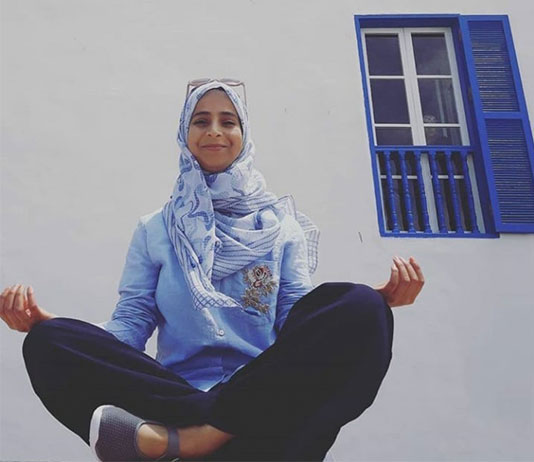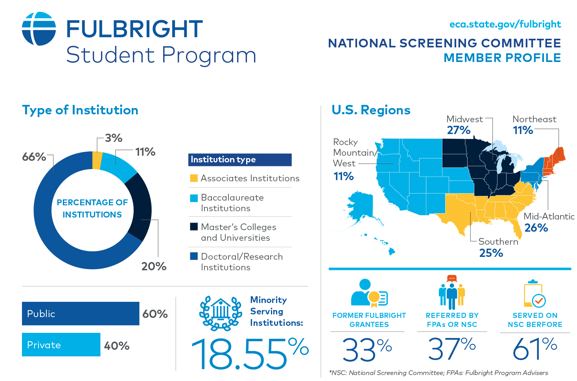This Arabic Language Day, we’re highlighting the contributions of outstanding Fulbrighters who live the Fulbright mission through sharing Arabic language and culture. In this Q&A, Fulbright Foreign Language Teaching Assistant Chama Bououd, an Arabic language FLTA at Stetson University, shares her experience teaching remotely, her tips for learning a foreign language, and what her students have learned about Morocco.
1. Tell us a little about your path to Fulbright. Who or what inspired you to apply?
Chama: My name is Chama Bououd. I am from Morocco and a native speaker of Arabic. I also speak French and English. I am interested in learning from other people and curious about other cultures. I believe that, now more than ever, we need to communicate and exchange our cultures and look from another’s perspective. I saw an opportunity in the Fulbright FLTA Program to experience American culture and share my own culture and native language, and was inspired by Fulbright’s mission to promote mutual understating of cultures and people.
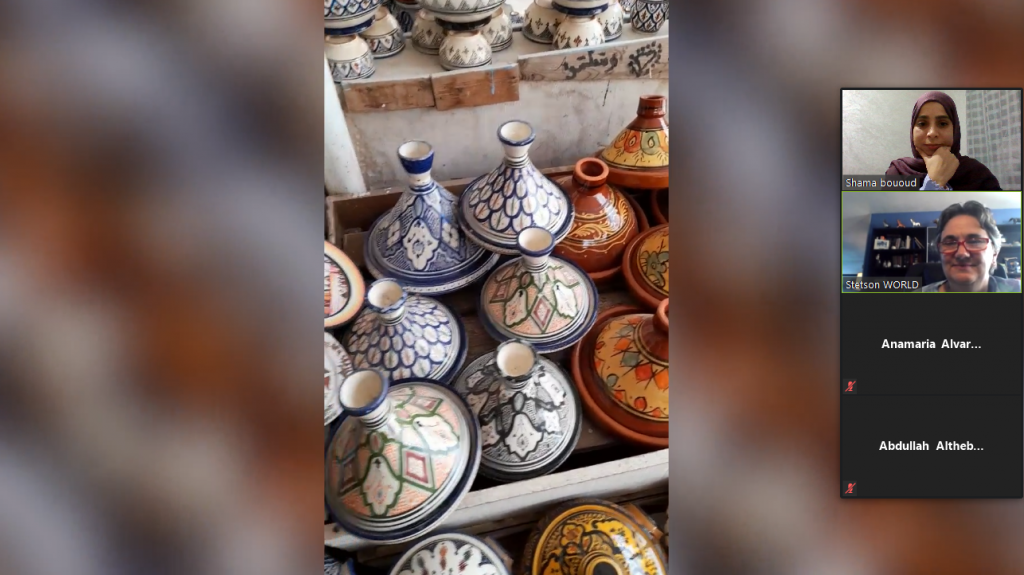
FLTA Chama Bououd introducing the Moroccan tajine, an earthenware pot and dish, to her Arabic class.
2. What tips and tricks have you learned for teaching a foreign language remotely? How have you engaged your students?
Chama: I had to teach remotely from home for the Fall 2020 semester. It was my first time studying and teaching online: teaching a language online is a bit demanding and can be challenging, but the primary instructor, my students, and I made it work. We did our best to cope with the circumstances and we succeeded. I tried to be creative during the classes, recording videos, using my hands and body language to explain and to overcome constraints. I shared Arabic culture, including funny expressions, music, videos, and through conversations, in order to engage all students, especially those beginning to study the Arabic script.
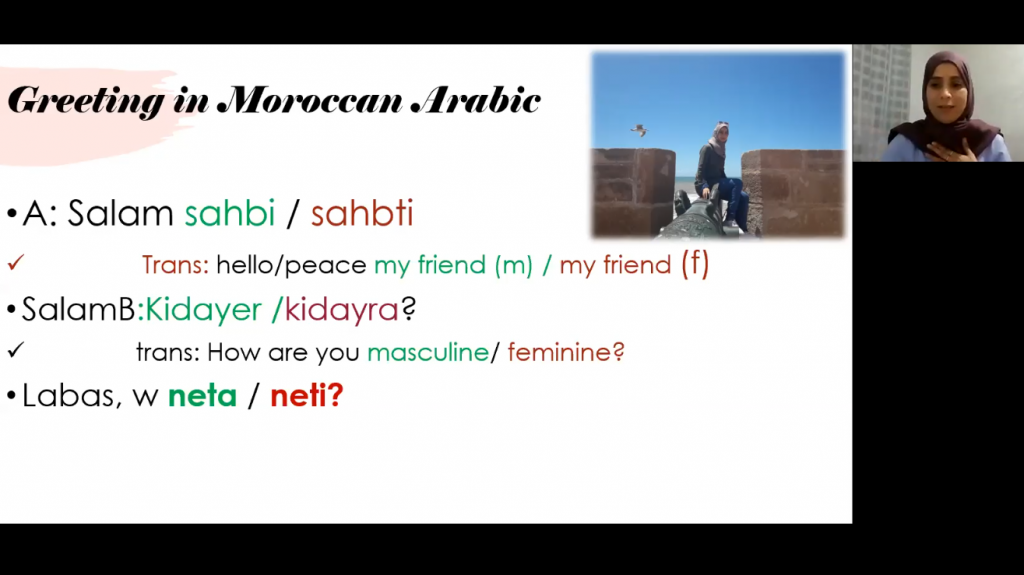
Chama teaching Arabic greetings for a beginning Stetson University Arabic language class.
3. What advice would you give to Arabic language learners, especially those learning via the internet?
Chama: For someone learning Arabic, I would recommend listening to Arabic music, watching movies, following pages that share Arabic content on social media, and watching Arabic videos on YouTube, etc. This enables learners to hear Arabic within context, and to see that Arabic exists beyond class and textbooks, especially for learners who do not live in an Arabic-speaking community. Besides, exposure to a foreign language improves learning, and no language can be learned in isolation from its culture.
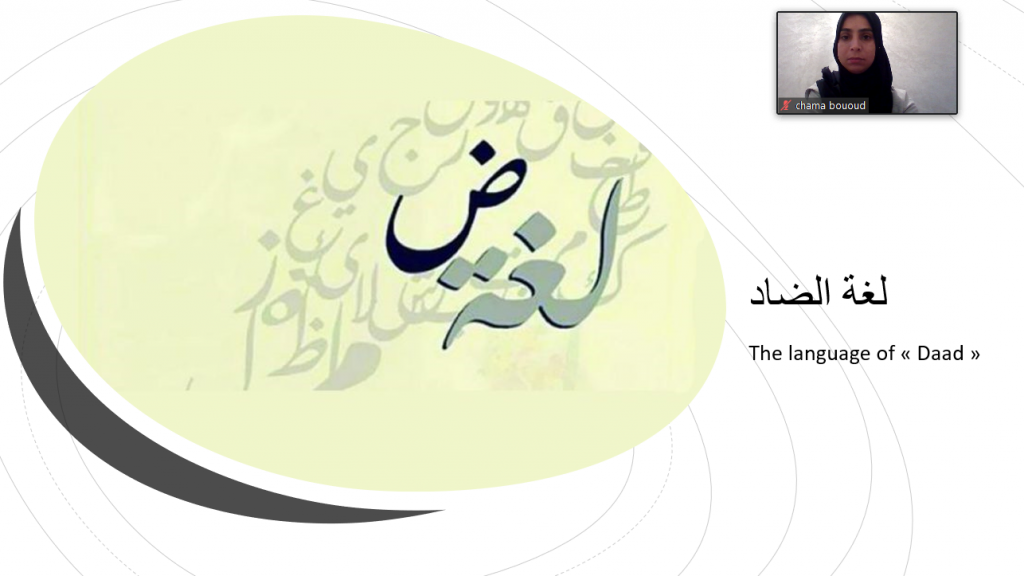
Chama introducing the Arabic letter “daad” to her Arabic class.
4. What might an American be surprised to learn about your home country?
Chama: I noticed that some of my American students and classmates thought that all Moroccan women cover their heads with a hijab, or that we were only allowed to wear black. I explained to my students about Moroccan hospitality, and they were surprised to learn that a host will keep offering guests food, and won’t take “no” for an answer. This is not to be imposing, but rather to be hospitable. I also explained that when shopping in Morocco, you must bargain: the actual price of the product might be half of what the seller is saying, because they expect the customer to bargain.
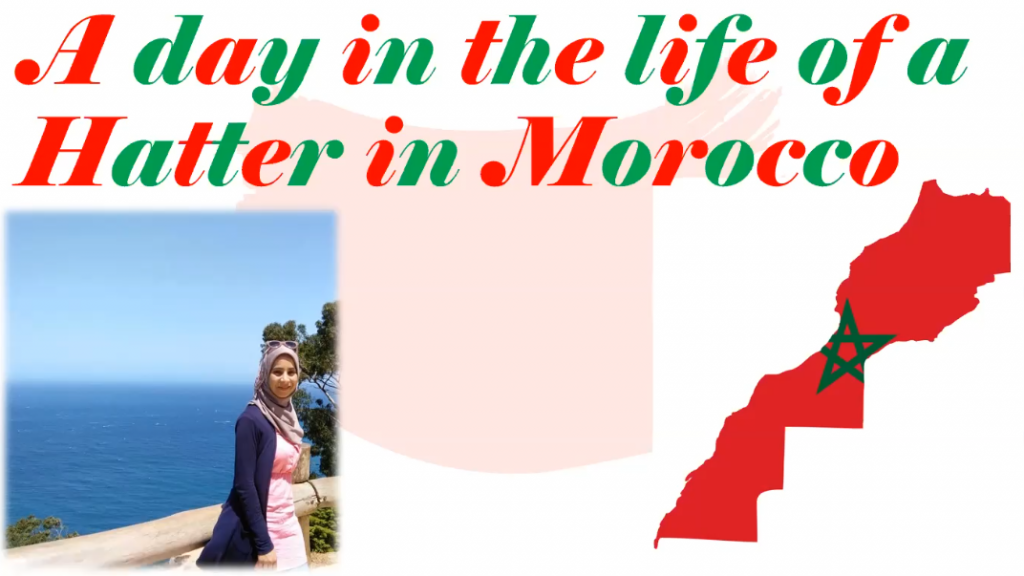
Chama’s presentation on Moroccan Hatters.
5. What is your biggest takeaway from your Fulbright Program?
Chama: My experience in the Fulbright Program has enabled me to look at the world from a different perspective. I have met so many wonderful and helpful people who have welcomed and supported me. I have made connections and learned a lot from my students and classes at Stetson University—this will definitely help me with my academic career and future plans.
Top 5 Fulbright Student Blog Posts of 2020
December 10, 2020Connecting Indigenous Communities: Native American Heritage Month Q&A
November 18, 2020This Native American Heritage Month, we’re highlighting the contributions of outstanding Fulbrighters who live the Fulbright mission through the ways in which they express their identities and their goals. In this Q&A, Fulbright Student Alumni Ambassador Vince Redhouse shares his experiences in Australia, where he learned about the relationship between Indigenous communities and the law.
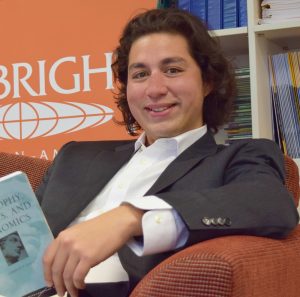 Vince Redhouse, 2015 Fulbright U.S. Student in Philosophy to Australia
Vince Redhouse, 2015 Fulbright U.S. Student in Philosophy to Australia
Vince Redhouse, the 2015 Anne Wexler Fulbright Scholarship in Public Policy recipient, studied at the Australian National University (ANU) in Canberra, where he completed an MPhil in Philosophy under the supervision of Robert E. Goodin. Vince’s thesis focused on the topic of political reconciliation between settler states and their indigenous citizens. In addition to his master’s program, Vince tutored for a course on Indigenous Culture through ANU’s Centre for Aboriginal Economic Policy Research, was a Visiting Research Fellow at the University of Canberra’s Centre for Deliberative Democracy and Global Governance, gave a TEDx presentation, and through support from both the ANU and the Lois Roth Endowment, visited Utopia, an indigenous community in the Northern Territory, where he was able to learn firsthand some of the issues Indigenous Australians face.
1. Tell us a little about your path to Fulbright. Who or what inspired you to apply?
Vince: My path was different than most. I am a first-generation college student and prior to my junior year of college, I had never heard of Fulbright! I was fortunate that one of my advisers recommended the program to me. There were two things that inspired me to apply: 1. An interest in the relationship between foreign Indigenous people and their settler colonial government; and 2. The opportunity to see if academia was right for me.
2. Tell us a little about your Fulbright research topic and project. What did a typical day as a Fulbrighter look like for you?
Vince: My Fulbright was for a two-year research degree: a Master of Philosophy (MPhil) in Philosophy at the Australian National University. My initial proposal was to examine and apply contemporary deliberative practices to see whether they could be used to dispel the false beliefs that societies hold about Indigenous peoples. What my proposal ended up being, however, was a normative evaluation of how political reconciliation could occur between Indigenous peoples and their settler colonial states. Ultimately, I argued that for political reconciliation to end legitimating settler colonial states, Indigenous citizens must be able to exit the process and reclaim their lands, should reconciliation fail or prove undesirable.
My research process was fairly routine: I commuted to my office(s) and did research at my computer most of the day. My university has an incredible tradition of taking tea twice a day, and I took advantage of that. It was a great opportunity for me to get feedback from professors and other students of all philosophical backgrounds in a friendly and casual environment. I also gave several research presentations, including a talk at the U.S. Embassy in Canberra and a TEDx talk, and was a pro bono tutor (i.e. graduate assistant) for an Aboriginal and Torres Strait Islander history and culture course taught by ANU’s Centre for Aboriginal Economic Policy Research. I was also a visiting research fellow at the University of Canberra Centre for Deliberative Democracy and Global Governance. From time to time, I was also able to meet and discuss issues with indigenous leaders and activists throughout the country—even spending a couple weeks in a remote indigenous reserve—as well as with members of the Prime Minister and Cabinet’s Indigenous Affairs team.
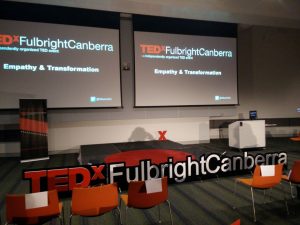

Caption: Vince at TEDxFulbrightCanberra, and with former U.S. Ambassador to Australia John Berry.
3. How did your identity play a role in your Fulbright experience?
Vince: My identity as a Navajo was absolutely crucial to my Fulbright experience. A lot of the experiences I described above were available to me solely because I was an Indigenous person from the United States. The Indigenous peoples of Australia were just as eager to learn from me as I was from them! For example, I was invited to tutor a course in Aboriginal history and culture in order to share my experiences as an Indigenous person from the United States. Similarly, I was invited to spend time on a remote Aboriginal reserve, where I saw firsthand the impact of Australia’s Indigenous education policies. I was able to share my own experiences about U.S. educational approaches on Indian reservations.
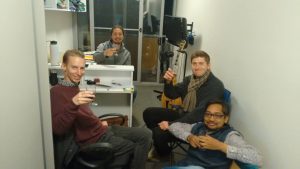
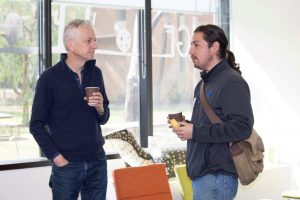
Caption: Vince having dinner and hanging out with his philosophy friends.
4. What is your biggest takeaway from your Fulbright?
Vince: That indigenous communities across the world should be working together. We share so many historical similarities and are working to fight so many of the same battles every day. I truly believe that if we work together and learn from each other that we can do more than just persevere, we can thrive!
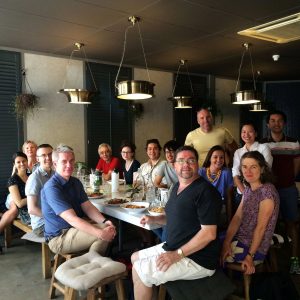
Caption: Vince (center back) sharing a meal with co-workers from the University of Canberra’s Centre for Deliberative Democracy and Global Governance.
5. What impact did your research or studies make in your career and local communities?
Vince: My Fulbright experience has had a tremendous impact on my life. It spurred me to go to law school and focus on Federal Indian law, but it also encouraged me to redouble my volunteer efforts working with Native American youth in the southwest United States. Currently, I run a professional alumni mentoring and scholarship program for Native students at the University of Arizona. Since taking over the program, I’ve been able to recruit a larger alumni community to mentor Native students and raise more scholarship funds for our students. My volunteer work collaborates with administrators to create mutually beneficial policy, and my experiences in Australia gave me the confidence to navigate and advocate in that arena.
6. How can native/indigenous students be supported and included in international education?
Vince: Fulbright should be more persistent about reaching out to Tribes, Tribal colleges, and international Indigenous communities about Fulbright opportunities. These connections are important not just for promoting Fulbright, but also for helping Indigenous students once they are abroad. Although Fulbright played a role in helping me make connections with Indigenous peoples in Australia, those connections were always indirect (e.g., a Fulbright alumnus introducing me to someone). Given Fulbright’s expansive alumni network and name recognition, I would like to see it strive to make those connections more directly.
By Uyanga Erdenebold, 2007 Fulbright Foreign Student from Mongolia
It stands clear and vivid in my memory as if it were yesterday. It was the clear, sunny morning of August 20, 2007 when I stood at the airport in Ulaanbaatar, Mongolia, equal degrees excited and nervous, surrounded by my family and getting ready to cross the globe to go to a country that I knew only from movies and books. As surreal as it seemed, I knew that this was the shining moment of my triumph. This was the moment I had worked for, and this is the moment that many, even myself, doubted would ever come. I had done it. I was going to the United States as the first-ever blind Fulbright Foreign Student from Mongolia. Though none of us knew at the time, this was to be the beginning of a long, transformative journey, and my relationship with the United States.
When I was 14, an American woman came to our school voluntarily and asked to teach interested students English. What struck us most was the fact that she was blind, just like us. To this day it amazes me how courageous she was to come so far from home all by herself. She ignited the first spark in me of the possibility of doing the same: traveling somewhere far and foreign and being bravely independent. She, not just by teaching me English but also by just being there, showed me that it could be done, and that I too could do it. She helped me to believe, and I was already halfway there.
Fulbright helped me to see the world, and the experience not only changed the course of my life, but more importantly, it changed me as an individual.
It freed me, quite literally, both in the physical and intellectual sense. Until I came to the United States, I had never gone anywhere by myself. I had never learned to walk with a cane. I was always accompanied either by a family member or a friend. Do you know what a privilege it is to be able to walk alone with your thoughts, stopping whenever or wherever you want to, taking as long as you would like to reach a certain place, just to wander around by yourself? That’s what the United States gave me: personal freedom. It was there that I first owned my own key to my apartment. Once I completed my cane training, I quickly moved on to guide dog training, and received my first guide dog in August 2008. My partnership with my first guide dog, Gladys, was one of the most positive, heart-warming, and transformative experiences of my life, and for this, I’m forever grateful to the United States.
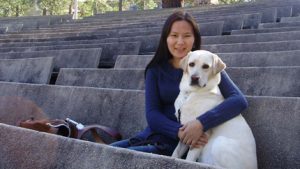
Fulbright Foreign Student Uyanga Erdenebold with her guide dog, Gladys.
I was never defined by my disability, even before I came to the United States. However, before then, I was defiant, always seeking to prove my worth. What the United States taught me was that I was already an equal, an acknowledged human being with the same right to contribute to society as everyone else. This liberated me from a huge burden I had carried all my life. Now I could focus on my studies just like everyone else. I would have been fine if my professors felt differently, especially with assignments and readings. But as far as they were concerned, the only difference between the other students and myself was that I had a pretty dog.
There were difficult days, of course, especially in the beginning – days when I wondered why I left the comfort of my home and my family and friends. I felt lonely, homesick, and frustrated. But those feelings are only natural. Remembering how hard you worked to get where you are and what you hope to achieve with this experience helps shed a different light on everything.
Once, a journalist asked me what I thought was the hardest thing in my life, and I said, “Not being able to contribute.”
The basic elements of a fulfilled human life are to be relevant, to be able to contribute, and to be acknowledged. Every human experience, all human knowledge, and every human feeling finds meaning only when shared. When you are judged not by the merit of who you are, but by the perceived limitations of your disability, your right to contribute quickly gets turned upside down and becomes a right to receive. If you don’t contribute, you become irrelevant and forgotten. The unfortunate truth is that society has a tendency to generalize and apply their notions of perceived limitations on you based on a lack of certain sense or physical attribute. But is ability determined by one’s physical attributes alone? A truer indicator of ability might be experience.
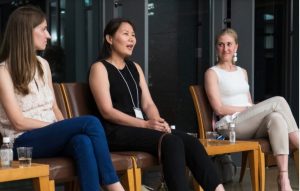
Uyanga Erdenebold speaking at a WomEmpowered International event in Tokyo, Japan.
Many people with disabilities usually have been told to be “realistic” in life, and have always had to prove themselves in order to get any type of recognition and value. People always assume incompetence, and it’s always on the person with a disability to prove them wrong. To have to do that with everyone you meet is incredibly exhausting. It’s similar to being forever on trial, where everyone you meet is the jury and you’re always assumed guilty—in other words, incompetent—until proven otherwise.
My one piece of advice to everyone working with a person with a disability is: ALWAYS ASSUME COMPETENCE.
Be willing to give trust and confidence without proof. Be willing to be the ally and not the jury. Be willing to go the extra mile even if it seems futile. What society expects from disabled people is to have such strong inner self-will and awareness that we can propel ourselves forward, even when everyone we meet always expects less from us compared to our non-disabled peers. For anybody, going to college and having a job is a normal part of life, and it’s expected as a matter of course. However, when those with disabilities achieve those same things, it’s a great success and an exception to be applauded. Why? Precisely because we are not expected to be able to do those things.
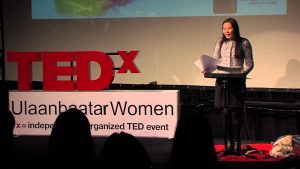
Uyanga Erdenebold presenting at TEDx UlaanbaatarWomen.
Before I went to the United States, I often arranged my life and my dreams to accommodate my disability. But after my Fulbright experience, I let my disability accommodate my life. I learned that there is much more to life than what meets the eyes, and there are endless opportunities if I only allow myself to find them.
Making the Grade: Five Things Every Applicant Should Know About the Fulbright U.S. Student Program Review Process
October 15, 2020By Fulbright Program Staff
Congratulations on submitting your Fulbright application! Now what? Have you ever wondered what happens to your Fulbright application after you hit “submit”? In this post, we’ll shed light on the Fulbright U.S. Student Program’s technical review and National Screening Committee (NSC) processes, illustrating how an applicant becomes a Fulbrighter.
1. First things first… Technical Review
After you hit “submit,” Fulbright Program staff first conducts a technical review of your application materials. Therefore, it pays to thoroughly review country descriptions and eligibility criteria at the beginning of your application journey to ensure that you meet all requirements. Check out our handy application checklist to make sure you don’t forget to include any application materials, too.
During our technical review, we double-check your biographical data, citizenship, transcripts, letters of recommendation, project plans, and more for eligibility and completeness. Make sure that ALL required materials are successfully uploaded and viewable in your online application portal—you won’t be able to add missing documents later! (Hint: Be sure to view and save a PDF copy of your application before submitting—you’ll have both a copy of your application for your records and be able to confirm that all documents are successfully submitted and readable!)
After confirming an application is eligible and complete, it is moved to the National Screening Committee (NSC) for review.
2. The NSC: The Reviewers (and What They Are Looking For)
During “NSC Season,” almost 200 committees meet to review and discuss all successfully submitted applications. Each application is sent to a committee of three reviewers a.k.a. NSC members, for a transparent, merit-based review process.
Who exactly are these reviewers? The individuals that review your application are typically university professors with expertise in either a) your academic/professional field, or b) the country or world region where you propose undertaking your Fulbright. Many are Fulbright alumni, while others have been recommended by Fulbright Program Advisers or other NSC members. Reviewers reflect the diversity of the U.S. higher education community and include panelists from minority-serving institutions (MSIs), Historically Black Colleges & Universities (HBCUs), and other underrepresented institutions.
Each committee reviews approximately 60-70 applications in advance of a meeting, scoring each submission based on specific review criteria. While all programs and applicants are unique, NSC reviewers look for well-researched, feasible research and community engagement projects, adequate academic and personal preparation for the proposed country or award, and personal attributes and qualities that illustrate a positive and passionate cultural ambassador of the United States to the world. Be authentically you!
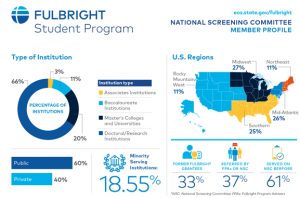
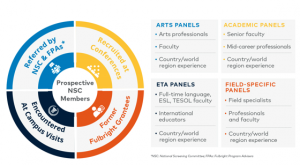
3. NSC Review Day
Throughout November and December, NSC reviewers gather for review meetings. Committees consist of three reviewers and one staff facilitator who directs the flow of the meeting, answers reviewers’ questions about the Fulbright Program, and records results. At these meetings, reviewers discuss each application using a collaborative approach and are welcome to adjust their scores based on their conversation. At the end of the meeting, final scores are tabulated by the staff facilitator, determining which candidates the committee recommends for further consideration during the host country review process.
4. Time & Consideration: The Breakdown
As you may have gathered, the NSC process is a massive undertaking! In 2019, 525 NSC members reviewed approximately 10,400 applications at 175 committee meetings in 6 different cities. From start to finish, more than 11,000 hours are spent screening, reviewing, and scoring each application. And that’s before the in-country review process!

5. The Decision
Based upon the NSC process, applications are designated as “Recommended” or “Non-Recommended.” All applicants are notified of their application’s status, and recommended applicants become “Semi-Finalists!” Recommended applications are forwarded to their respective Fulbright host countries for an additional round of selection, taking into account Fulbright Commission and U.S. Embassy priorities. During this period, Semi-Finalists undertaking research or graduate degree programs may be asked to submit letters of acceptance or affiliation from their proposed institution, so it’s important to receive all necessary documents as soon as possible. In some cases, host countries may also choose to contact Semi-Finalists for short phone or video chat interviews, in order to get a better sense of the person behind the application.
After months of concentrated effort by both applicants and Fulbright Program staff, host countries will share final application notifications on a rolling basis between February and May. Successful applicants are sent an award offer, and are officially known as “Finalists.” Qualified applicants not selected as Finalists may become “Alternates,” or potential awardees that may receive an award offer, should additional funding become available. Non-selected applicants are encouraged to celebrate their Semi-Finalist status, and reapply for the next award cycle. Even those who are not selected should feel extremely proud of their efforts, and know that many parts of the application can be applied to future endeavors beyond Fulbright, such as applying to graduate school.
The Fulbright U.S. Student Program application process is undoubtedly long. We hope this article provides some clarity into the process, and helps you create the best application you can. In writing, editing, and discussing your candidacy with friends, mentors, Fulbright Program Advisers, and other individuals, you may gain greater insight into your passions, your reasons for pursuing a Fulbright, other transferable skills you possess, and insight into our world. Our best wishes for a successful application and bright future!

